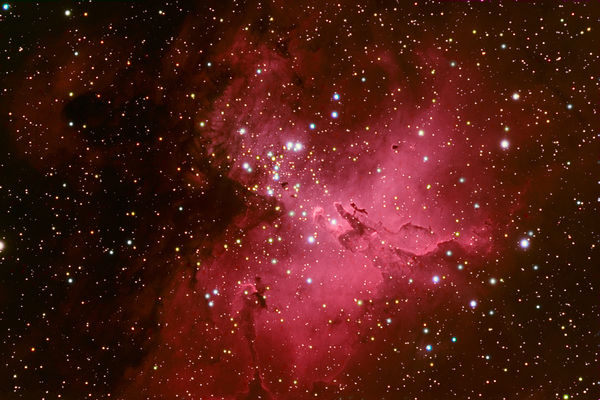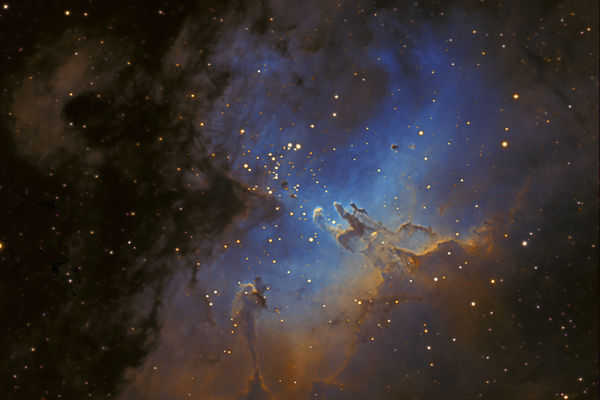M16 and the Pillars of Creation
Jul 10, 2021 13:51:34 #
Ballard
Loc: Grass Valley, California
M16 (Messier object 16 also know as the Eagle Nebula) is an open star cluster surrounded by Nebula in the constellation Serpens Cauda (The snakes tail). The cluster is ~5700 light years away and was given fame from the Hubble image know as the Pillars of Creation.
Below are some images of the Cluster and Nebula I took last week. The first was made from separate Luminance, Red, Green, Blue and Ha Filters (The Ha is a narrow band filter Hydrogen Alpha filter at ~656 nanometers). The Ha data was added to the red data since this is very red. The first image is ~ what the nebula would look like to our eyes if they where sensitive enough to see the image in color. The second image was made with separate narrow band filters, OIII (501 Nanometer) used to show ionized oxygen emmission lines , Ha is used to show the Hydrogen Alpha emmission lines and SII (672 Nanometer) is used to show ionized sulfur emission lines, ) and where combined in what is called the Hubble Palette. If you download the images you can easily make out the "Pillars of Creation" in both views).
For the Hubble Palette the OIII data is used for the blue channel, the Ha is used for the green channel and the SII is used for the red channel. This products a false color image but makes it easier to see the composition of a nebula. Note: The Ha (green channel) is there throughout the nebula and when combined with the SII (red channel) produces the golden color and the OIII combined with the Ha produces the light blue aqua color. Note: Note the green channel is the strongest and had to be reduced to allow the other colors to show though. All question comments and suggestions are welcome.
Below are some images of the Cluster and Nebula I took last week. The first was made from separate Luminance, Red, Green, Blue and Ha Filters (The Ha is a narrow band filter Hydrogen Alpha filter at ~656 nanometers). The Ha data was added to the red data since this is very red. The first image is ~ what the nebula would look like to our eyes if they where sensitive enough to see the image in color. The second image was made with separate narrow band filters, OIII (501 Nanometer) used to show ionized oxygen emmission lines , Ha is used to show the Hydrogen Alpha emmission lines and SII (672 Nanometer) is used to show ionized sulfur emission lines, ) and where combined in what is called the Hubble Palette. If you download the images you can easily make out the "Pillars of Creation" in both views).
For the Hubble Palette the OIII data is used for the blue channel, the Ha is used for the green channel and the SII is used for the red channel. This products a false color image but makes it easier to see the composition of a nebula. Note: The Ha (green channel) is there throughout the nebula and when combined with the SII (red channel) produces the golden color and the OIII combined with the Ha produces the light blue aqua color. Note: Note the green channel is the strongest and had to be reduced to allow the other colors to show though. All question comments and suggestions are welcome.
LRGB + HA image of the nebula (What it would look like to the eye )

(Download)
False color narrow band filter image (used to more easily see what the nebula is made of)

(Download)
Jul 10, 2021 14:15:13 #
Jul 10, 2021 14:18:39 #
Jul 10, 2021 14:22:40 #
Ballard
Loc: Grass Valley, California
BassmanBruce wrote:
Absolutely amazing shots, nice work. 

Hi BassmanBruce
Thanks for checking out the image of the eagle nebula, for the comment and the Thumbs up.
Jul 10, 2021 14:23:12 #
Ballard
Loc: Grass Valley, California
bonjac wrote:
WOW!
Hi bonjac
Thanks for viewing the image of M16 and for the comment.
Jul 10, 2021 14:26:31 #
Jul 10, 2021 14:27:43 #
Ballard
Loc: Grass Valley, California
RichKenn wrote:
Awesome! Thanks.
RichKenn
Thanks for checking out my versions of the "Pillars of Creation" and for the comment.
Jul 10, 2021 14:36:53 #
Jul 10, 2021 14:39:55 #
Ballard wrote:
M16 (Messier object 16 also know as the Eagle Nebu... (show quote)
Mindbogglingly beautiful shots 💫💞🌀💞💫
Jul 10, 2021 14:44:46 #
Ballard
Loc: Grass Valley, California
angler wrote:
Excellent shots.
Hi angler
Thanks for checking out the images of M16 and for the comment.
Jul 10, 2021 14:46:12 #
Ballard
Loc: Grass Valley, California
joecichjr wrote:
Mindbogglingly beautiful shots 💫💞🌀💞💫
Hi joecichjr
Thanks for viewing shots of the Eagle nebula and for the comment.
Jul 10, 2021 15:56:55 #
Jul 10, 2021 15:59:16 #
Ballard
Loc: Grass Valley, California
Longshadow wrote:



Hi Longshadow
Thanks for checking out the Eagle nebula shots and for the Thumbs up.
Jul 10, 2021 16:03:17 #
Ballard wrote:
Hi Longshadow
Thanks for checking out the Eagle nebula shots and for the Thumbs up.
Thanks for checking out the Eagle nebula shots and for the Thumbs up.
I am amazed by what is out there, and the sizes!
Jul 10, 2021 16:16:39 #
Ballard
Loc: Grass Valley, California
Longshadow wrote:
I am amazed by what is out there, and the sizes!
Hi Longshadow
Indeed there are lots of amazing things to look at out there and the sizes are mind boggling. In the case of the Eagle nebula the main Pillar is ~90 trillion km long (9.5 light years). The Star clusters in the nebula consists of around 8100 stars and is thought to be between 1 and 2 million years old (a very young cluster).
If you want to reply, then register here. Registration is free and your account is created instantly, so you can post right away.




